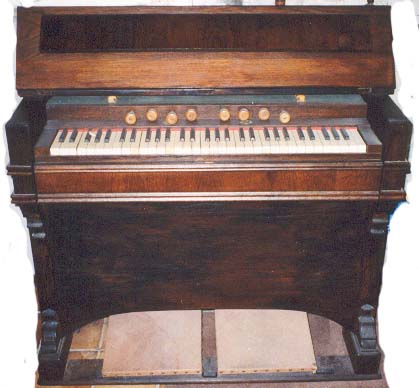Can anybody give
me a hint how the stop faces originally looked like,and submit information
how they should read correctly?
The harmonium has a typical pressure-harmonium-style
oak case with simple carvings, the hinges and two handles are made
of brass. The keys are Ivory-plated. The stop board is not enameled black
as seen in most harmoniums. The stop knobs and pulls have been left
unstained and show the natural colour of light wood. Above the keyboard,
there are two medals attached. One of them shows the name of the manufacturer
"J. Trayser & Cie, Stuttgart", the other one lists four industrial
exhibitions at which the manufacturer won prize medals: München, Paris
and last Stettin 1868. So the instrument should be dated on a year after
1868.
After several hints given by the community of reed organ afficionados I found the serial number of the Instrument where it ought to be ( numbers are hammered into the wood of the upper side of the left part of the case, near the left hinge) - but some former refurbishing of the Instrument (sandig and varnishing) made it difficult to see. I had to take a strong quartz light bulb to find it. So now I can date the Instrument: The serial reads 101XX (five digit number, the latter two numbers are sanded down ad unreadable) . The engravings on the medal
plates show the Year 1868. According to the
ROS
Reed Organ database , the Trayser serial number 11696 matches
with the year 1867 - so, the serial number 101XX should correspond
to that time.
The instrument was found some years ago in the attic of a village
school in northern Germany in very bad condition, and has been partly
restored by the former owner:
The top board including the key cover have been replaced, and the
bellows (exhausters/ reservoir) has been rebuilt completely. As far
as I can judge, the latter was done by an expert. The carpets on the treadles
were replaced by patches of leather, and most of the wood has been stained
in a rather dark colour. The music rack is missing, but one visitor of this website gave me some detailled hints how it looked like.
Can anybody tell me,
whether the treadles
were covered originally with carpets or with leather?
The last years the instrument spent in a garage and now it
is awaiting a final restoration .... up to now, I unfortunately had no time for that work.
